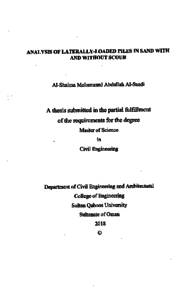Document
Analysis of laterally-loaded piles in sand with and without scour.
Publisher
Sultan Qaboos University
Gregorian
2018
Language
English
English abstract
Abstract
The objective of this study is to evaluate the ability of different analytical methods to predict the behavior of a single pile and pile groups under lateral load installed in sand with and without scour conditions and to modify these methods to improve their prediction capabilities. Three analytical methods were adopted to predict response of a single pile: p y curve, Poulos, CLM methods. To predict the behavior of group piles two analytical methods were used: Papadopoulou and Comodromos method and Gandhi method. The analysis was performed was performed for both single piles and a group piles with and without scour conditions. The prediction capabilities of the analytical methods are compared to the results from small scale, and full scale experiments. Both loose and dense sand were considered. First, the above three analytical methods were used to predict the response of single piles without scour. p -y curve method is capable to predict almost exact load-deflection curves as the experimental results when a variable value of soil stiffness is used. CLM and Poulos methods are also giving good results. For group piles, Ghandi method predictions gave slightly different load deflection curve from the experimental results. However, Papadopoulou and Comodromos method predictions are different from experimental results. The above analytical methods are modified in this study to take into account the effect of scour by increasing the eccentricity of the applied load due to scour. The modified p - y method is capable of predicting similar load deflection curves as the experiments for a single pile under scour conditions. Group piles under scour are simulated perfectly by Ghandi method, but Papadopoulou and Comodromos method gave different results from experimental.
Description
Thesis
Member of
Resource URL
Arabic abstract
تهدف هذه الدراسة إلى تقييم قدرة الطرق التحليلية المختلفة على التنبؤ بسلوك خازوق مفرد أو مجموعة خوازيق مثبتة في الرمل و تحت تاثير الأحمال الجانبية مع وبدون حالة تجريف ، وإلى تعديل هذه الطرق لتحسين قدرتها على التنبؤ بهذا السلوك وقد تم تبني ثلاث طرق تحليلية في هذه الدراسة للتنبؤ باستجابة خازوق مفرد بطريقة منحنی و - p، وطريقة Poulos وطريقةCLM .وللتنبؤ باستجابة مجموعة خوازيق فقد تم استخدام طريقتين تحليليتين وهما: طريقة غاندي و طريقة Papadopoulou و Comodromos. تم تقسيم البرنامج التحليلي إلى قسمين رئيسيين مفرد أو مجموعة خوازيق. وتمت دراسة استجابة وتأثير عمق التجريف على هذه الحوازيق ، وقد تم مقارنة النتائج مع نتائج التجارب المعملية والحقلية، وذلك من خلال دراسة الخوازيق المثبتة في التربة الرملية الرخوة والكثيفة. تم استخدام الطرق التحليلية الثلاث المذكورة أعلاه للتنبؤ بسلوك الخوازيق بدون تجريف ، حيث نتج أن طريقة منحنی py-، وباستخدام قيمة صلابة التربة كمتغير مع زيادة الحمولة الجانبية تعطي نتائج مطابقة للتجارب المعملية والحقلية. كما وأعطت طريقة CLM وطريقة Poulos نتائج جيدة أيضا. وبالنسبة لمجموعة خوازيق فإن طريقة غاندي تتوافق مع المنحنيات. أما طريقة Papadopoulou و Comodromos فقد أعطت نتائج مختلفة عن التجارب المعملية والحقلية ولدراسة الخوازيق في حالة التجريف تم تعديل طرق التحليل اعلاه ، وذلك من خلال زيادة ارتفاع موضع الحمولة عن سطح الأرض بعد الإنجراف، ونتيجة لذلك فإنه طريقة منحنى المعدلة قادرة على التنبؤ بسلوك الخازوق المفرد تحت حالة التجريف. حيث أن العامل الرئيسي للحصول على منحني دقيق هو الصلابة الأولية مع موضع تاثير التجريف في الحد من صلابة التربة في عين الاعتبار، كما تم محاكاة مجموعة الخوازيق تحت حالة التجريف تماما بطريقة غاندي
عند زيادة ارتفاع موضع الحمولة عن سطح الأأرض في عين الإعتبار ، بينما لم تتوافق طريقة Comodromos النتائج المعملية والحقلية
Papadopoulou و
عند زيادة ارتفاع موضع الحمولة عن سطح الأأرض في عين الإعتبار ، بينما لم تتوافق طريقة Comodromos النتائج المعملية والحقلية
Papadopoulou و
Category
Theses and Dissertations

